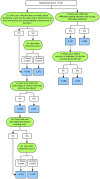Quantifying Risk for Anxiety Disorders in Preschool Children: A Machine Learning Approach
- PMID: 27880812
- PMCID: PMC5120781
- DOI: 10.1371/journal.pone.0165524
Quantifying Risk for Anxiety Disorders in Preschool Children: A Machine Learning Approach
Abstract
Early childhood anxiety disorders are common, impairing, and predictive of anxiety and mood disorders later in childhood. Epidemiological studies over the last decade find that the prevalence of impairing anxiety disorders in preschool children ranges from 0.3% to 6.5%. Yet, less than 15% of young children with an impairing anxiety disorder receive a mental health evaluation or treatment. One possible reason for the low rate of care for anxious preschoolers is the lack of affordable, timely, reliable and valid tools for identifying young children with clinically significant anxiety. Diagnostic interviews assessing psychopathology in young children require intensive training, take hours to administer and code, and are not available for use outside of research settings. The Preschool Age Psychiatric Assessment (PAPA) is a reliable and valid structured diagnostic parent-report interview for assessing psychopathology, including anxiety disorders, in 2 to 5 year old children. In this paper, we apply machine-learning tools to already collected PAPA data from two large community studies to identify sub-sets of PAPA items that could be developed into an efficient, reliable, and valid screening tool to assess a young child's risk for an anxiety disorder. Using machine learning, we were able to decrease by an order of magnitude the number of items needed to identify a child who is at risk for an anxiety disorder with an accuracy of over 96% for both generalized anxiety disorder (GAD) and separation anxiety disorder (SAD). Additionally, rather than considering GAD or SAD as discrete/binary entities, we present a continuous risk score representing the child's risk of meeting criteria for GAD or SAD. Identification of a short question-set that assesses risk for an anxiety disorder could be a first step toward development and validation of a relatively short screening tool feasible for use in pediatric clinics and daycare/preschool settings.
Conflict of interest statement
I have read the journal's policy and the authors of this manuscript have the following competing interests: Dr. Carpenter has served as a paid consultant to the Zero to Three DC:0-3R Revision Task Force. No other authors report competing interests. This does not alter our adherence to PLOS ONE policies on sharing data and materials.
Figures





Similar articles
-
[Prevalence of depressive disorders in children and adolescents attending primary care. A survey with the Aquitaine Sentinelle Network].Encephale. 2003 Sep-Oct;29(5):391-400. Encephale. 2003. PMID: 14615688 French.
-
[Sensitivity and specificity of the worry and anxiety questionnaire (WAQ) in a sample of health-care users in the province of Quebec].Encephale. 2008 Jun;34(3):240-8. doi: 10.1016/j.encep.2007.01.008. Epub 2007 Oct 24. Encephale. 2008. PMID: 18558144 French.
-
A profile of social, separation and generalized anxiety disorders in an Australian nationally representative sample of children and adolescents: Prevalence, comorbidity and correlates.Aust N Z J Psychiatry. 2018 May;52(5):446-460. doi: 10.1177/0004867417741981. Epub 2017 Nov 29. Aust N Z J Psychiatry. 2018. PMID: 29185356
-
The epidemiology of generalized anxiety disorder.Psychiatr Clin North Am. 2001 Mar;24(1):19-39. doi: 10.1016/s0193-953x(05)70204-5. Psychiatr Clin North Am. 2001. PMID: 11225507 Review.
-
[Diagnostic structured interviews in child and adolescent's psychiatry].Encephale. 2004 Mar-Apr;30(2):122-34. doi: 10.1016/s0013-7006(04)95422-x. Encephale. 2004. PMID: 15107714 Review. French.
Cited by
-
Estimating classification consistency of machine learning models for screening measures.Psychol Assess. 2024 Jun-Jul;36(6-7):395-406. doi: 10.1037/pas0001313. Psychol Assess. 2024. PMID: 38829349 Free PMC article.
-
Testing the bipolar assumption of Singer-Loomis Type Deployment Inventory for Korean adults using classification and multidimensional scaling.Front Psychol. 2024 Jan 31;14:1249185. doi: 10.3389/fpsyg.2023.1249185. eCollection 2023. Front Psychol. 2024. PMID: 38356992 Free PMC article.
-
Early COVID-19 quarantine: A machine learning approach to model what differentiated the top 25% well-being scorers.Pers Individ Dif. 2021 Oct;181:110980. doi: 10.1016/j.paid.2021.110980. Epub 2021 May 12. Pers Individ Dif. 2021. PMID: 36471777 Free PMC article.
-
An intelligent Bayesian hybrid approach to help autism diagnosis.Soft comput. 2021;25(14):9163-9183. doi: 10.1007/s00500-021-05877-0. Epub 2021 May 24. Soft comput. 2021. PMID: 34720705 Free PMC article.
-
High separation anxiety trajectory in early childhood is a risk factor for sleep bruxism at age 7.Sleep. 2020 Jul 13;43(7):zsz317. doi: 10.1093/sleep/zsz317. Sleep. 2020. PMID: 31894243 Free PMC article.
References
-
- Stein MB. An epidemiologic perspective on social anxiety disorder. J Clin Psychiatry. 2006;67 Suppl 12:3–8. Epub 2006/11/10. . - PubMed
MeSH terms
Grants and funding
LinkOut - more resources
Full Text Sources
Other Literature Sources
Medical

